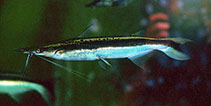muatnaik fotos/gambar dan video
Pictures | Stamps, coins, misc. | imej GoogleSorubim lima
Picture by JJPhoto
Pictures | Stamps, coins, misc. | imej GoogleSorubim lima
Picture by JJPhoto
Colombia country information
Common names:
Blanquillo, Paletón
Occurrence: native
Salinity: freshwater
Abundance: | Ref:
Importance: | Ref:
Aquaculture: | Ref:
Regulations: | Ref:
Uses: no uses
Comments: Known from the Atrato, Sinú, San Jorge and Magdalena rivers (Ref. 26543).
National Checklist:
Country Information: https://www.cia.gov/library/publications/resources/the-world-factbook/geos/co.html
National Fisheries Authority:
Occurrences: Occurrences Point map
Main Ref: Lundberg, J.G. and M.W. Littmann, 2003
National Database:
Occurrence: native
Salinity: freshwater
Abundance: | Ref:
Importance: | Ref:
Aquaculture: | Ref:
Regulations: | Ref:
Uses: no uses
Comments: Known from the Atrato, Sinú, San Jorge and Magdalena rivers (Ref. 26543).
National Checklist:
Country Information: https://www.cia.gov/library/publications/resources/the-world-factbook/geos/co.html
National Fisheries Authority:
Occurrences: Occurrences Point map
Main Ref: Lundberg, J.G. and M.W. Littmann, 2003
National Database:
Common names from other countries
klasifikasi / Names Nama-nama umum | Sinonim (persamaan) | Catalog of Fishes(Marga, Jenis) | ITIS | CoL | WoRMS | Cloffa
> Siluriformes (Catfishes) > Pimelodidae (Long-whiskered catfishes)
Etymology: Sorubim: Brazilian local name, sorubim (Ref. 45335); lima: Name from Latin 'lima' meaning file, referring to the ventrally exposed premaxillary tooth patch (Ref. 57983).
More on authors: Bloch & Schneider.
Etymology: Sorubim: Brazilian local name, sorubim (Ref. 45335); lima: Name from Latin 'lima' meaning file, referring to the ventrally exposed premaxillary tooth patch (Ref. 57983).
More on authors: Bloch & Schneider.
Environment: milieu / climate zone / depth range / distribution range Ekologi
; air tawar dasar (demersal); pH range: 6.5 - 7.8; dH range: ? - 20. Tropical; 23°C - 30°C (Ref. 1672); 8°N - 11°S
Penyebaran Negara-negara | Daerah-daerah FAO | Ecosystems | Kemunculan | Point map | Introduksi | Faunafri
South America: Amazon, Orinoco, Paraná and Parnaíba River basins. Syntopic with S. elongatus in the Orinoco basin and with S. elongatus and S. maniradii in the upper Amazon drainage of Brazil, Ecuador, Peru, and Bolivia (Ref. 57983).
Length at first maturity / Size / Weight / umur
Maturity: Lm 23.2 range ? - ? cm
Max length : 54.2 cm TL jantan/; (Ref. 79585); Berat maksimum terpublikasi: 1.3 kg (Ref. 40637)
Max length : 54.2 cm TL jantan/; (Ref. 79585); Berat maksimum terpublikasi: 1.3 kg (Ref. 40637)
deskripsi pendek Kunci identifiaksi (pengenalan) | Morfologi | Morfometrik
Duri punggung (Keseluruhan (total)) : 2; duri punggung lunak (Keseluruhan (total)) : 6; Sirip dubur lunak: 19 - 22. Distinguished from S. elongatus by having modally 9 pectoral rays; 21 anal-fin rays; 16 gill rakers; large vomerine tooth patches, almost always fused; a more robust, deeper head and body; body somewhat compressed laterally; mental barbels equal or anterior to gular apex. Differs from S. cuspicaudus in having rounded caudal fin lobes and more robust body; from S. trigonocephalus by premaxillary tooth patch length being 1.5 to 2.5 times its width; trenchantly differs from S. maniradii in having only 13-18 gill rakers. Additionally, other distinguishing characters include, pelvic fins that contact or nearly reach anal fin origin when depressed and presence of thin plates or ossicles (highly variable in shape) extending vertically on anterior lateral line in most large adults (Ref. 57983).
Occurs in schools. Is mainly nocturnal. Feeds primarily on fishes and crustaceans (Ref. 9084).
Life cycle and mating behavior Kematangan | Reproduksi, perkembang biakan | Pemijahan | telur-telur | Fecundity | Larva
Verify.
rujukan utama
Upload your references | Acuan | Koordinator | mitra
Lundberg, J.G. and M.W. Littmann, 2003. Pimelodidae (Long-whiskered catfishes). p. 432-446. In R.E. Reis, S.O. Kullander and C.J. Ferraris, Jr. (eds.) Checklist of the Freshwater Fishes of South and Central America. Porto Alegre: EDIPUCRS, Brasil. (Ref. 36506)
Status IUCN Red List (Ref. 130435: Version 2024-2)
kurang bimbang (LC) ; Date assessed: 07 November 2018
ancaman kepada manusia
Harmless
penggunaan manusia
Perikanan: nilai komersial kecil; Akuarium: Komersial
FAO(Aquaculture systems: production; ; publication : search) | FishSource |
informasi lanjut
Population dynamics
Growth parameters
Max. ages / sizes
Length-weight rel.
Length-length rel.
ukuran frekuensi
Mass conversion
pemulihan
Kelimpahan
Growth parameters
Max. ages / sizes
Length-weight rel.
Length-length rel.
ukuran frekuensi
Mass conversion
pemulihan
Kelimpahan
Life cycle
Reproduksi, perkembang biakan
Kematangan
Fecundity
Pemijahan
Spawning aggregations
telur-telur
pekembangan telor
Larva
Dinamika larva
Reproduksi, perkembang biakan
Kematangan
Fecundity
Pemijahan
Spawning aggregations
telur-telur
pekembangan telor
Larva
Dinamika larva
Anatomy
Area insang
Brain
Otolith
Area insang
Brain
Otolith
Physiology
Body composition
Nutrients
Oxygen consumption
Swimming type
Swimming speed
Visual pigments
Fish sound
Diseases & Parasites
Toxicity (LC50s)
Body composition
Nutrients
Oxygen consumption
Swimming type
Swimming speed
Visual pigments
Fish sound
Diseases & Parasites
Toxicity (LC50s)
Alat, peralatan
Bio-Quiz | E-book | Penuntun lapangan | tanda freqkuenci panjang | peringkat sejarah hidup | peta titik | Classification Tree
| Catch-MSY |
laporan khas
muat turun XML
Sumber internet
Aquatic Commons | BHL | Cloffa | Websites from users | semak peneliti ikan | CISTI | Catalog of Fishes(Marga, Jenis) | DiscoverLife | ECOTOX | Faunafri | Fishtrace | GenBank(genom, Nukleotida) | GloBI | GOBASE | | Google Books | Google Scholar | Google | IGFA World Record | MitoFish | Pangkalan data nasional | Otolith Atlas of Taiwan Fishes | Akuarium publik | PubMed | Reef Life Survey | Scirus | SeaLifeBase | Tree of Life | Wikipedia(pergi, Cari) | World Records Freshwater Fishing | Zoological Record
Estimates based on models
Phylogenetic diversity index (Ref. 82804): PD50 = 0.5312 [Uniqueness, from 0.5 = low to 2.0 = high].
Bayesian length-weight: a=0.00479 (0.00316 - 0.00725), b=3.12 (3.00 - 3.24), in cm Total Length, based on LWR estimates for this species & (Sub)family-body (Ref. 93245).
Trophic level (Ref. 69278): 4.1 ±0.71 se; based on food items.
Daya lenting (Ref. 120179): sedang, Waktu penggandaan populasi minimum 1.4 - 4.4 tahun (K=0.27).
Fishing Vulnerability (Ref. 59153): Moderate vulnerability (39 of 100).




